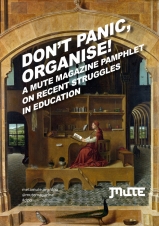Latino Performance Delivered To Your Home (Net Performance by Coco Fusco and Ricardo Dominguez)
On 22 November, Coco Fusco underwent 12 hours of confinement in a room of the Finnish Contemporary Art Centre Kiasma. The interactive performance, Dolores from 10 to 22 hrs, was relayed by CCTV to the net.

The net performance was the staging of a true story revealed to Fusco in 1998 during an interview with a maquiladora worker from the USA-Mexican border. The woman was forced to remain twelve hours in a room of the factory, deprived from access to a telephone, a toilet, food or drink, as a measure to enforce her resignation. Fusco initially produced a radio piece from the interview, which followed her research into the work conditions in the border maquiladoras. The research underscored a systematic violation of civil rights as a symptom of the globalising economic development that is affecting most Latin American countries. In this context, it is worth signalling that border assembly plants have a preference for the employment of women, who make up 70% of the workforce.
On the screen, virtual spectators could witness Dolores undergoing boredom, isolation and abuse from her employer. The lack of action worked here as a trigger for increasing tension. From a semiotic viewpoint, the performance revealed - and threatened- the invisibility of working class Latin American women in an economically and technologically excluding society for which they assemble machines. It is worth pointing out that most of them live in improvised shantytowns, which mushroom around the assembly plants lacking in basic services such as electricity and clean water.
In the border assembly plant scenario, strategies of minimum investment relate to the low cost of both the land and the workforce. This fundamental force pushes the permanent migration of the plants to more deprived areas. This, according to Fusco, represents in turn a symbolic castration. The constant closing of the factories is related to the highest level of dependence and desperation of women on the move, as immigrants in border areas form the base of labour.
According to film studies theorist Lola Young, the absence of representation of non-white women in cinema and media has a double cause. One the one hand, it relates to the Freudian castration complex and to the viewing pleasure of the male spectator, but is also aggravated by a materialist context. Some groups in society have the right to look openly while others, only illicitly.
Fiction and reality operate simultaneously in Dolores from 10 to 22 Hs, and make it unreadable as parody. In the position of the spectator, we become accomplices in a docu-drama of oppression and instability atypical of the net.
During her work in tandem with Mexican performance artist Guillermo Gomez-Pena in the 90s, Fusco presented the piece The Couple in the Cage . The work was a parody in the style of the ethnographic museum diorama that exposed the artists in a cage representing natives of an imaginary Caribbean island. The two 'discovered' objects of fascination were displayed in museums and public spaces around the world triggering a variety of reactions from the public that reflected on contemporary racial prejudice and evidenced the problems of cultural supremacy in the context of difference.
If The couple in the Cage staged an uncomfortable misunderstanding as an exposure of cultural stereotypes, Dolores... transcends it in utilising the medium - the Internet or virtual cage - as a container of both confinement and massive dispersion. In her recent collected writings 'The Bodies that were not Ours', Coco Fusco deconstructs the problematic identification of technology as a liberating tool in so far it perpetuates the mechanism of power and consumerism of the world in the virtual realm. The body - locus of the subject - and its absence seem to encompass the tensions between the forces of power relations in both 'spaces'. Examples such as porn sites on the web delivering exotic beauties to avid mental tourists or the disappearing working women in the border area act as signs of race and social determinants in the objectification of human beings.

The martyrdom inflicted upon Dolores/Fusco during the performance due to the forced confinement developed at a slow pace to the point of violence. The tactics employed by the repressive figure of the manager - Dominguez spanned between the denial of access to a lavatory to a simulated rape. The objectification of the surveyed subject is emblematic of the contradiction operating in the liberating discourse associated to the myth of access. The exposure of the painful reality suffered by Dolores not only disembodies her but us the passive spectators.
Electronic art that debates these issues provide an arena for further action. Ricardo Dominguez, with his Electronic Disturbance Theatre subverts the standard applications of surveillance cameras perverting the roles of the watcher/watched. Formed as an actor in the Shakespearean tradition, Dominguez exemplifies the activist-electronic artist who employs technology to revert surveillance into documenting the abuses of power and inciting direct action.
His work in Chiapas and in Australian indigenous reservations provides a platform for action to counterbalance the traditional application of surveillance to control individuals. One of his most impressive operations took place as a flooding of the Mexican Government web page. The loading of the names of murdered indigenous activists forced the Government to acknowledge a fact that was concealed from the public. The flooding operation forced the closing of the page in various occasions. The invisible spectator of Dolores... becomes a voyeur who is dragged into the acknowledgement of a dehumanising act that makes him/her an accomplice. To which extent this intervention derives into positive action - the stopping of the exploitation - remains to be seen.
Four hundred and fifty people visited the chat-room and fifteen hundred visitors viewed the site. Some of the participants in the chat seemed to be increasingly interested in the escalation of violence, wondering when would Dolores be punished. According to the artist statement, this troubling sample is a signifier of the tensions between pleasure and terror, intimately linked within the narratives of surveillance systems.
In the essay The maximum surveillance society , British sociologists Clive Morris and Gary Armstrong, identify CCTV and cameras for Internet delivery as contemporary versions of the Foucaultian panopticon.
Who watches whom? Foucault's vision reflects on the subliminal power dynamics reproduced by the model of the ideal prison conceived by Benjamin Betham. In turn, our role as wardens of the virtual prison reminds us of mass consumed programs such as 'Big Brother'.
The woman enclosed in her stereotypical frame -either metaphorical or physical- is a residue of peep show culture magnified by the latest generator of fantasy: the net.
Real life Dolores sued her employers, but could never prove her confinement as nobody testified as to have seen her. Coco Fusco and Ricardo Dominguez invited us to witness it. Dolores represents an uncomfortable example of the passive subject we all might desire to possess and control.
Gabriela Salgado <gabssalgado@appleonline.net> is curator at the University of Essex, Collection of Latin American Art
Footnotes:
<1> An Arabic term that entered Mexico via Spain to signify the processing of foreign grains.<2> Young, Lola, 'Fear of the Dark: race, gender and sexuality in the cinema', Verso, UK<3> Fusco, Coco, 'English is broken here. Notes on cultural fusion in the Americas', The New Press, New York<4> Fusco, Coco, 'The Bodies that were not ours' inIVA, Routledge, London, 2001<5> Morris, Clive and Armstrong Gary, 'The maximum surveillance society: the rise of CCTV', Berg, Oxford, New York, 1999
Mute Books Orders
For Mute Books distribution contact Anagram Books
contact@anagrambooks.com
For online purchases visit anagrambooks.com






